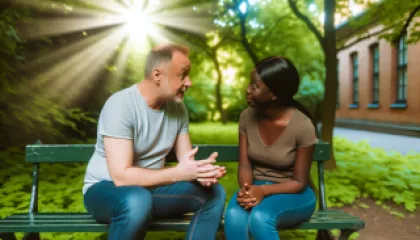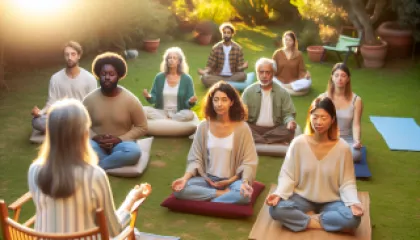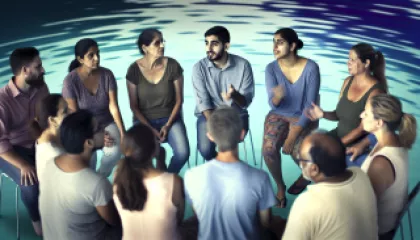How to Declutter Your Mind and Home with Mindful Clutter Therapy Sessions
How to Declutter Your Mind and Home with Mindful Clutter Therapy Sessions
Clutter is a common challenge that many of us face, both in our physical spaces and our mental landscapes. It can be overwhelming to look around and see piles of belongings, stacks of paperwork, and a mind constantly buzzing with thoughts, to-do lists, and unfinished tasks. However, the good news is that there is a solution: mindful clutter therapy sessions.
In this comprehensive guide, we'll delve into the psychology of clutter and explore how to use a therapeutic approach to declutter your mind and home. By the end of this article, you'll be equipped with the knowledge and tools to embark on a transformative journey towards a more organized, peaceful, and intentional way of living.
Understanding the Psychology of Clutter
Clutter is not just a physical manifestation of our possessions; it is deeply rooted in our emotional and psychological well-being. Studies have shown that the presence of clutter can have a significant impact on our mental health, leading to increased stress, anxiety, and even depression.
At its core, clutter is often a reflection of our subconscious desires, fears, and experiences. For many people, the accumulation of possessions can be a coping mechanism for unresolved emotional issues, a way to fill a void, or a means of avoiding difficult decisions. Letting go of these items can be incredibly challenging, as they may hold sentimental value or represent a part of our identity.
Moreover, the constant visual stimuli of clutter can overwhelm our senses, making it difficult to focus, relax, and find a sense of inner peace. The cognitive load of navigating through piles of belongings can also contribute to feelings of being overwhelmed and a lack of control.
Introducing Mindful Clutter Therapy
Mindful clutter therapy is a holistic approach that combines the principles of mindfulness, psychology, and organizational strategies to help individuals reclaim their physical and mental spaces. This therapy-based method goes beyond simply decluttering the home; it delves into the root causes of clutter and teaches individuals to cultivate a more intentional and fulfilling relationship with their possessions.
The core of mindful clutter therapy is the understanding that our relationship with our belongings is a reflection of our internal landscape. By addressing the emotional and psychological factors that contribute to clutter, individuals can gain a deeper understanding of themselves and develop strategies to let go of the unnecessary, make room for the meaningful, and create a harmonious living environment.
The Benefits of Mindful Clutter Therapy
Engaging in mindful clutter therapy sessions can offer a multitude of benefits, both in the short and long term. Some of the key advantages include:
Reduced Stress and Anxiety
By decluttering your physical and mental spaces, you can experience a significant reduction in feelings of stress and anxiety. The removal of visual clutter and the sense of control over your environment can have a calming effect on the mind, allowing you to feel more relaxed and focused.
Improved Focus and Productivity
A decluttered environment, both physically and mentally, can enhance your ability to concentrate and be more productive. With fewer distractions and a clear sense of organization, you can devote your attention to the tasks at hand without feeling overwhelmed or distracted.
Enhanced Mindfulness and Self-Awareness
The process of mindful clutter therapy encourages individuals to engage in introspection and self-reflection. As you explore the deeper meaning behind your possessions and the emotional attachments you hold, you'll develop a greater understanding of your values, priorities, and the underlying reasons for your clutter-related behaviors.
Improved Mental and Physical Well-Being
Clutter has been linked to various negative health outcomes, including poor sleep quality, increased risk of accidents, and even a weakened immune system. By addressing the psychological aspects of clutter and developing healthier habits, you can experience improved physical and mental well-being, leading to a higher quality of life.
Increased Sense of Clarity and Control
The process of mindful clutter therapy empowers individuals to take control of their physical and mental environments. As you let go of unnecessary possessions and streamline your thoughts, you'll feel a greater sense of clarity, organization, and personal agency, which can have far-reaching positive effects on your overall well-being.
The Steps of Mindful Clutter Therapy
Engaging in mindful clutter therapy sessions involves a step-by-step process that combines self-reflection, organizational strategies, and a therapeutic approach. Here's a breakdown of the key steps:
1. Assess Your Current Situation
The first step is to take a honest look at your current physical and mental clutter. This involves carefully examining your living spaces, identifying areas of concern, and reflecting on the emotional attachments and thought patterns that contribute to the accumulation of possessions and mental clutter.
To begin, consider the following questions:
- What areas of your home or workspace feel the most cluttered or overwhelming?
- What types of items or thoughts seem to accumulate the most?
- How do you feel when you're surrounded by clutter or when your mind is racing with endless tasks and worries?
- What are the underlying reasons or emotions that drive your clutter-related behaviors?
By taking the time to honestly assess your current situation, you'll gain valuable insights that will guide you through the subsequent steps of the process.
2. Establish Clear Intentions and Goals
With a clear understanding of your current clutter-related challenges, the next step is to set specific intentions and goals for your mindful clutter therapy sessions. This might include:
- Developing a more intentional and meaningful relationship with your possessions
- Creating a more peaceful and productive living or work environment
- Cultivating a greater sense of calm and focus in your daily life
- Addressing the root causes of your clutter-related behaviors and thought patterns
By establishing clear and achievable goals, you'll be able to track your progress and stay motivated throughout the decluttering process.
3. Engage in Mindful Decluttering
The heart of mindful clutter therapy is the act of decluttering, which involves carefully examining each item or thought and making conscious decisions about its role in your life. This process is guided by the principles of mindfulness, which encourage you to be present, non-judgmental, and deeply attuned to your thoughts, feelings, and physical sensations.
As you go through your possessions or mental clutter, ask yourself the following questions:
- Does this item (or thought) bring me joy, serve a purpose, or align with my values and goals?
- What emotional attachment or meaning do I have to this item (or thought)?
- How does this item (or thought) make me feel when I encounter it?
- Is this item (or thought) truly necessary, or is it contributing to the overall sense of clutter in my life?
By approaching the decluttering process with mindfulness, you'll be able to make more intentional and informed decisions about what to keep, what to let go of, and how to create a more harmonious living or mental environment.
4. Develop Organizational Strategies
Once you've completed the mindful decluttering process, the next step is to implement organizational strategies that will help you maintain a clutter-free environment. This may involve:
- Creating designated storage and display areas for your remaining possessions
- Developing a filing system or digital organization method for important documents and information
- Establishing routines and habits that support ongoing decluttering and tidiness
- Incorporating mindfulness practices, such as regular check-ins or meditation, to maintain a clear mental state
By establishing effective organizational systems, you'll be able to sustain the progress you've made and prevent the re-accumulation of clutter in both your physical and mental spaces.
5. Cultivate Mindful Habits and Behaviors
The final step in the mindful clutter therapy process is to integrate the principles and strategies you've learned into your daily life. This involves developing mindful habits and behaviors that support your decluttering efforts and promote a more intentional and balanced approach to your possessions and mental landscape.
Some examples of mindful habits and behaviors include:
- Regularly assessing and addressing areas of physical or mental clutter
- Practicing gratitude and mindfulness when interacting with your belongings
- Implementing a "one-in, one-out" policy when acquiring new items
- Incorporating mindfulness techniques, such as deep breathing or meditation, to maintain a clear and focused mind
- Regularly reviewing and updating your organizational systems to ensure they still serve your needs
By cultivating these mindful habits and behaviors, you'll be able to maintain a decluttered and harmonious living and mental environment, allowing you to focus on what truly matters most in your life.
The Role of Clutter Therapy Sessions
While the steps outlined above provide a comprehensive framework for engaging in mindful clutter therapy, many individuals find it beneficial to work with a trained therapist or coach who specializes in this approach. Clutter therapy sessions offer several advantages, including:
Professional Guidance and Accountability
A trained therapist or coach can provide invaluable guidance, support, and accountability throughout the decluttering process. They can help you explore the underlying emotional and psychological factors contributing to your clutter, offer strategies and tools for effective decluttering, and hold you accountable to your goals and intentions.
Personalized Approach
Every individual's relationship with clutter is unique, shaped by their personal experiences, beliefs, and emotional needs. A clutter therapy professional can tailor the approach to your specific circumstances, ensuring that the process is meaningful, effective, and aligned with your individual needs and goals.
Emotional Support and Healing
The process of letting go of possessions and addressing the root causes of clutter can be emotionally challenging. A therapist or coach can provide a safe and supportive environment, helping you navigate the emotional ups and downs and fostering personal growth and healing.
Ongoing Maintenance and Sustainability
Clutter therapy sessions don't stop at the initial decluttering process; they also focus on developing strategies for long-term maintenance and sustainability. Your therapist or coach can help you establish routines, habits, and systems that will support your continued efforts to maintain a clutter-free and harmonious living and mental environment.
Case Study: Londyn's Journey with Mindful Clutter Therapy
Londyn, a busy professional in her 30s, had been struggling with clutter for years. Her home was constantly overwhelmed with piles of paperwork, unused gadgets, and sentimental items she couldn't bear to part with. This physical clutter was mirrored by the mental clutter that plagued her, with racing thoughts, unfinished tasks, and a constant sense of being overwhelmed.
After attending a workshop on mindful clutter therapy, Londyn decided to take the plunge and work with a therapist who specialized in this approach. During their initial sessions, Londyn explored the deeper emotional attachments and experiences that had contributed to her clutter-related behaviors.
"I realized that a lot of the items I was holding onto were tied to memories of my childhood and the need to feel secure. As I started to understand these underlying drivers, I was able to let go of many possessions that no longer served me."
- Londyn
With the guidance of her therapist, Londyn embarked on a mindful decluttering journey, carefully examining each item and making conscious decisions about what to keep, what to donate, and what to let go of. This process not only cleared her physical spaces but also helped to quiet the mental chatter and restore a sense of calm and focus in her daily life.
"The most transformative part of the process was the shift in my mindset. Instead of feeling overwhelmed by clutter, I started to see it as an opportunity to create the life I truly wanted. I became more intentional about the items I brought into my home and the thoughts I allowed to occupy my mind."
- Londyn
As Londyn continued her mindful clutter therapy sessions, she also worked with her therapist to develop organizational strategies and habits that would help her maintain the progress she had made. This included creating designated storage areas, implementing a digital filing system, and incorporating regular check-ins and decluttering routines into her daily life.
Today, Londyn's home and mind are significantly more decluttered and peaceful. She reports feeling more focused, productive, and in control of her life. The journey wasn't always easy, but Londyn is grateful for the transformation she has experienced through her mindful clutter therapy sessions.
"Letting go of the physical and mental clutter has allowed me to make room for the things that truly matter. I feel more grounded, centered, and able to focus on the priorities that align with my values and goals. It's been life-changing."
- Londyn
Conclusion: Embracing a Decluttered Life
Mindful clutter therapy offers a transformative approach to reclaiming your physical and mental spaces, helping you cultivate a more intentional, balanced, and fulfilling way of living. By addressing the underlying psychological factors that contribute to clutter, developing effective organizational strategies, and integrating mindful habits and behaviors, you can experience the profound benefits of a decluttered life.
Whether you choose to embark on this journey independently or work with a trained therapist or coach, the key is to approach the process with compassion, patience, and a willingness to explore the deeper aspects of your relationship with your possessions and your mental landscape. By doing so, you'll unlock a newfound sense of clarity, control, and well-being that will positively impact every facet of your life.
So, take the first step towards a decluttered mind and home, and embark on a journey of self-discovery, personal growth, and harmonious living. The rewards await you.
Keywords used in the article:
- therapy for hoarding habits
- clutter therapy sessions
- clean space clean mind






